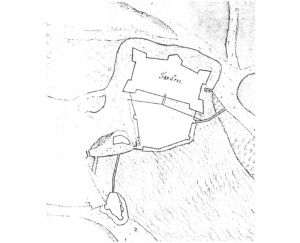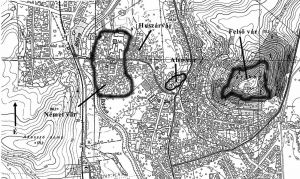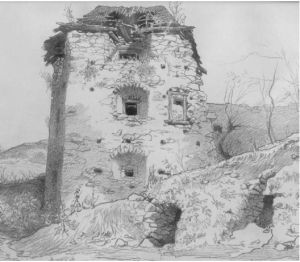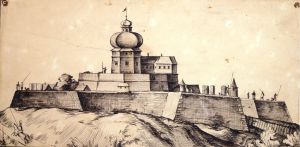The History of Alsóvár (Lower Castle) and Németvár (German Castle)
It is very likely that originally in the area of Szendrő three castles existed at the same time. Based on the archaeological research of Gábor Tomka, the medieval fortress most probably stood in the present-day centre of the settlement, north of the Reformed Church. Its remains can still be seen among the houses today. Lower Castle was the earliest of the castles with an identified location.

The Castle of Szendrő and its royal castellan, János Sándor Cselenfi's son, are first mentioned in written sources in 1355. Presumably, at the beginning of King Sigismund's reign, Szendrő, along with other fortresses, also fell into private hands. The castle and the manor belonging to it were obtained by the sons of judge royal István Bebek from Pelsőc. In 1404, the so-called Bebek Castle, also known in researches as Lower Castle, was not only a manorial centre, but also the residence of the owner family. From the middle of the 16th century, the history of the castle was also influenced by the events of the country. In 1545, Ferdinand I tried unsuccessfully to occupy the castle from György Bebek of the Szapolyai party. Finally, in 1566, Maximilian II, Holy Roman Emperor with the help of General Lazarus von Schwendi, succeeded in occupying Bebek Castle, thereby strengthening its position in the northeastern part of the country. In 1577, following the accession of King Rudolf to the throne, a council of war was held to determine the policy to be pursued against the Turks. At the war council, which adopted the defense strategy, the development proposals of the individual border fortresses were discussed; it was at this time that the decision to further develop Szendrő was made as well. The surviving ledgers testify an accelerated, large-scale construction. In the 1570s a new fortification was set up in a swampy, flat area surrounded by the arms of the Bódva River, west of Bebek Castle. It was a fortress called German Castle by the locals, as the builders and engineers used the German language, and its construction was important mainly for the protection of the Habsburg territory. Based on the depictions, the floor plan of the well-known five-bastion German Castle, the fortress surrounded by the arms of Bódva, expanded with the Hussar castle, can be observed also in today's settlement structure.

However, the fort did not stand for long, as the regularly occurring great floods of the river gradually eroded its foundations, thus severely damaging it. In 1690, Lower Castle was bought by Count István Csáky, who built a manor house on the northern side of the current Heroes' Square, on the site of the castle. The Csáky Manor House incorporated the two bastions and surrounding walls of the former castle. In the 18th century, Antal Csáky had further alterations made to the building. Although only the ruins of the manor house can be observed today, the 19-20th-century photographs and drawings show the former building complex.

Upper Castle, The Castle of Szendrő Based on a plans of Christoforo Stella, a military engineer and architect, on a designated area on Várhegy (Castle Hill) of about 1.2 hectares, did the construction of Upper Castle, in the last decade of the 16th century, begin. At the high-elevation of the castle courtyard was the inner castle, surrounded by about 2.2 meters thick masonry, in the middle of which stood a three-storey tower. In 1639, the central tower, the castle walls and the bastions were already standing. It can also be seen from these representations that the tower had a pyramid hip roof during this period.

The gate to the west of the inner castle was connected to the tower by a two-story building, and wooden emplacements on the inside of its wall provided protection. The entrance at the eastern base of the northeastern bastion served for chariots, cavalry, and pedestrians. In the first half of the 17th century, the troops of István Bocskai, Gábor Bethlen and György Rákóczi, I attempted to occupy the castle also. “In 1659, the Turks of Eger were pillaging the region of Szendrő and ventured all the way to the castle, where they beheaded the captured coachman of András Bárius. The old captain András Hatvani, with his German and Hungarian gallant soldiers, followed him to Kazincz and clashed with him there. A strong battle developed between them, and the Turks defeated the less numerous Hungarians. András Hatvani himself fell and the Turks took his head to Eger.” In 1645, the army of Transylvanian prince György Rákóczi, I, after the occupation of Lower Castle and German Castle, besieged Upper Castle from the north, but despite breaking through the castle wall, it failed to occupy it. Following the siege, the castle area was being rebuilt. The tower of the inner castle may have been renovated, and the open cannon emplacements may have been converted to enclosed ones, after the siege. The wooden-structured cannon emplacements that had previously been standing in the courtyard of the inner castle were demolished, the inner side of the walls was reinforced with a sloping earthwork, and an emplacement for the cannons was created on the upper level. The renewed baroque-like onion dome of the tower can clearly be seen in the 1664 depictions as well.

The floor plan, dated by the research to 1670, indicates the state after the modernization of Upper Castle. According to this, by this time the reinforcement of the southern dams and bastions had been completed, and based on the marking of the cannon chambers, the filling of the northwestern bastion had also been completed. In 1692, lightning struck the octagonal tower standing in the middle of the inner castle, as a result of which a large amount of gunpowder stored there exploded. The commander’s buildings were so badly damaged that in 1702 the Viennese court military council instead of carrying out restoration works, ordered the castle to be demolished; this, however, was prevented by the Rákóczi War of Independence.

The castle was still able to withstand the siege of the Kuruc army for a long time, however, after the city had burnt down in 1704 and the fortification was under siege, it was handed over to the kurucs together with all the cannons and other military equipment. Ferenc Rákóczi, II prince of Transylvania decided to demolish the castle in early 1707; the bastions and walls were blown up under the direction of French military engineer Lemaire. The wall sections connecting the bastions survived the blast; the wall remains were probably taken down by the locals and used as building material. The military career of Upper Castle of Szendrő with that was over. We can recall the golden age of the late monumental renaissance fort through the relics getting into surface, the partial renovation and the European Union’s innovations occurred in the course of lately research.
